Launched in 2023, Project Ek Sau Ek is a transformative initiative focussed on improving farmers' income through practical, science-based agricultural practices. By introducing methods like trench planting, bio-compost fertilisation, and water-efficient irrigation, the Project shows that sustainable sugarcane farming can be both profitable and climate-resilient. The goal is clear: improve the livelihoods of sugarcane farmers while safeguarding natural resources.
Our Vision: To expand these straightforward interventions across more sugarcane farming communities, creating a lasting, sustainable future for farmers.
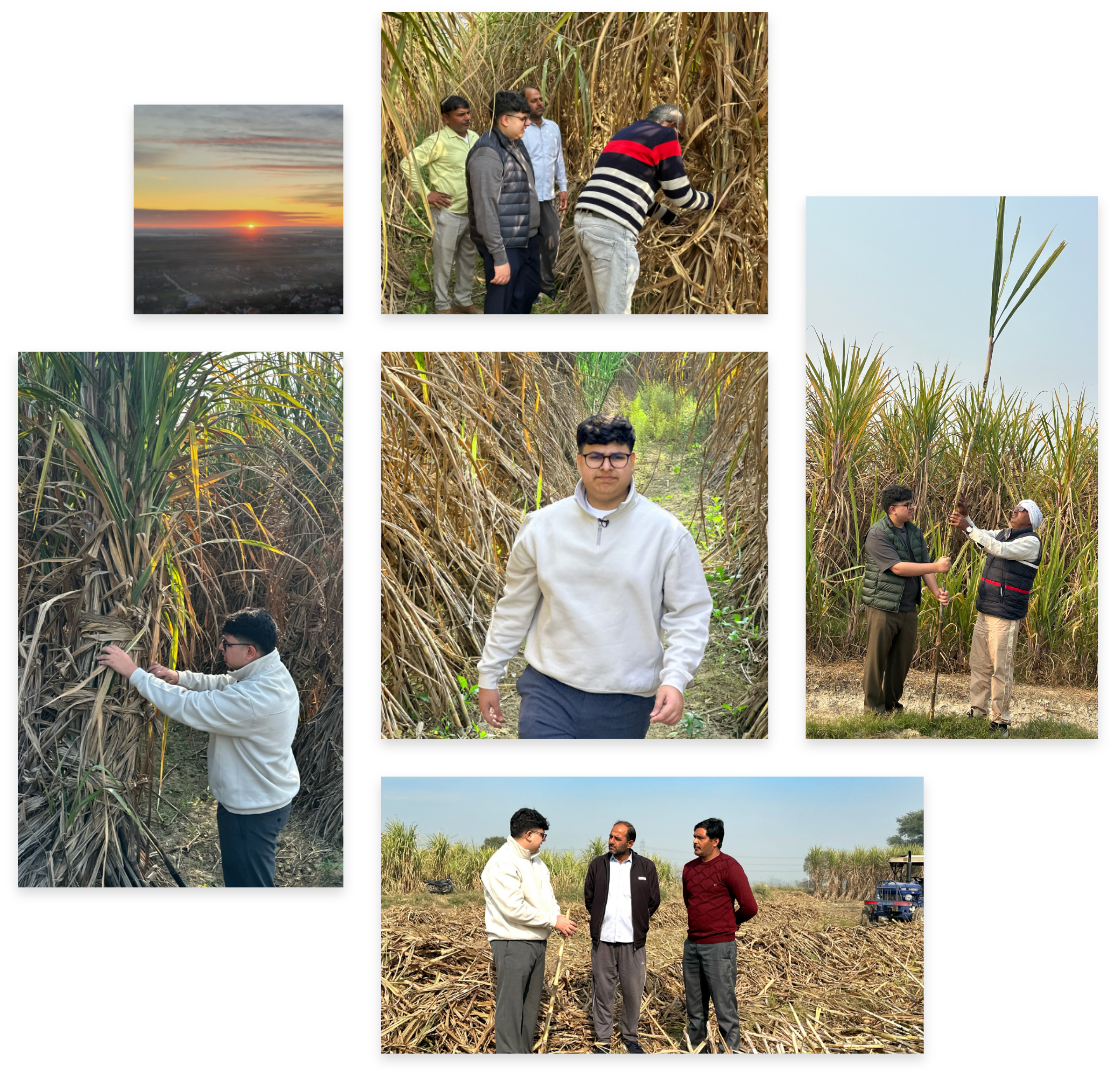
Yash Dhruv Sawhney is a student at Winchester College, UK, where he studies Mathematics, Biology, Chemistry, and Geography. He is the founder of EkSauEk (101), an initiative that has now expanded to work with 1,001 farming families across India to make sugarcane cultivation more sustainable. The project brings together scientific learning and traditional wisdom, helping farmers adopt practices that improve yields, protect the soil, and strengthen their financial well-being. In 2024, Yash partnered with Haqdarshak to help farmers access government support schemes, and his educational pamphlets on sustainable farming have reached over 200,000 farmers.
His research on sustainable agriculture was published in the Journal of the International Society of Sugar Cane Technologists and presented at the 2025 ISSCT Global Conference in Cali, Colombia where he recieved a plaque for being the youngest ever presenter amongst leading professionals in the field. He has also written on the role of ethics in modern business, with work featured in the Journal of Student Research and Sapientia Research Journal, where he now serves as Co-Chief Editor.
Beyond the field, Yash has interned with the World Wildlife Fund for Nature (WWF) in New Delhi, working with teams supporting more than 100,000 farmers in biodiversity and river rejuvenation projects. At Winchester, he serves as Deputy Head of Community Service and Head of Faith Circles, leading placements, mentoring younger students, and helping build spaces of dialogue and reflection. He has also contributed to curatorial projects at the College Treasury, and worked on the Jane Austen 250th Anniversary Exhibition, earning him the Headmaster’s Award for Distinguished Contribution.
Yash also hosts “The Mindful Muncher”, a podcast exploring food chemistry and sustainable agriculture. His work through Ek Sau Ek, including a short documentary, has been recognised by several international film festivals and featured in national media.
What began in 2023 as Project Ek Sau Ek—a small yet ambitious initiative with just 100 farmers—has now become a movement. Inspired by the tangible results achieved in the first phase, a wave of sugarcane growers expressed their eagerness to join. Listening to this call, we expanded the programme to include 1,000 motivated farmers in the current phase.
The transformation speaks for itself:

These practical, research-backed methods are central to Project Ek Sau Ek’s mission: providing farmers with tools and knowledge that improve yields, increase incomes, and support sustainable farming.
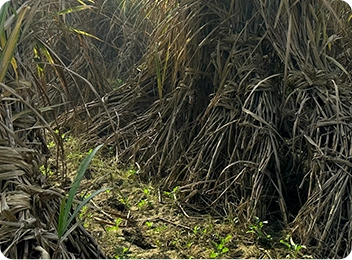
By digging 30 cm deep trenches with 4-feet spacing between rows, farmers can increase sugarcane yields by 15%-18%. This method also allows for mixed cropping, where food grains like black gram and green gram are grown alongside sugarcane, providing farmers with an additional source of income.
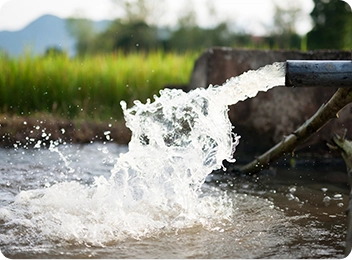
Unlike traditional flood irrigation, this technique delivers water directly to the roots, cutting water use by 30%. It's a simple change that conserves water while supporting healthy crop growth.
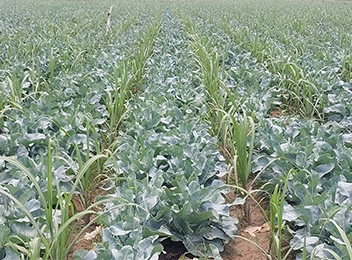
Intercropping sugarcane with crops such as tomatoes, cauliflower, and green gram has generated additional revenue gains of up to 18% for farmers. The intercrop residues serve as effective green manure, helping to increase sugarcane yield while improving soil fertility.
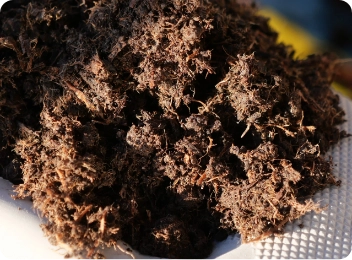
Project Ek Sau Ek promotes bio-compost made from cow dung and farmyard manure. Regular use has increased soil organic carbon levels by over 0.50%, improving soil health and long-term fertility.
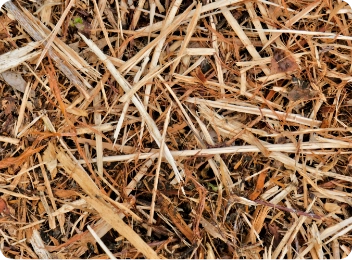
Instead of burning sugarcane residue, it’s reused as mulch. This helps retain soil moisture, reduce chemical use, and cut carbon emissions by preventing crop burning.
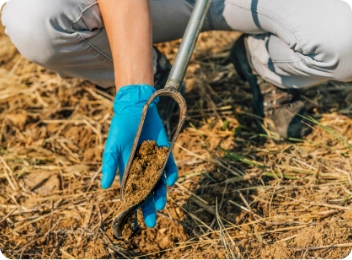
Soil tests conducted across 100 farms guide fertiliser use. This approach prevents chemical overuse, improves crop health, and boosts yields.
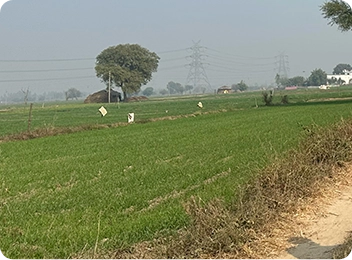
Treating sugarcane seeds with Imidacloprid and Thiophanate-Methyl protects against pests and fungal diseases, increasing germination rates and reducing losses.
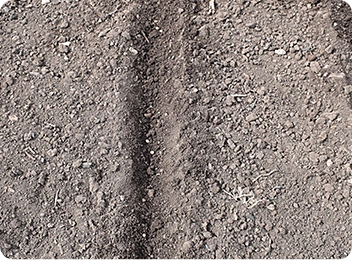
Applying this natural fungal agent helps prevent soil-borne diseases, promoting stronger, healthier crops.

Drones are used to spray micronutrients evenly across tall crops, ensuring proper nutrient distribution while saving on labour costs.
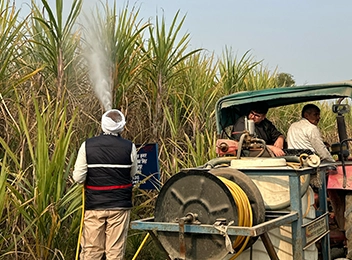
Based on soil test results, potash is applied during the earthing-up process. This strengthens plant roots, improves juice quality, and increases cane weight, directly boosting yields and profitability.
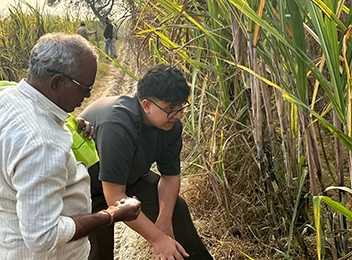
Using single-bud seed sets reduces seed costs by 62% and raises germination rates to nearly 90%. It’s an efficient method that enhances nutrient uptake and promotes better crop development.
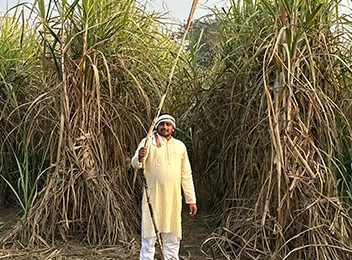
To prevent lodging (when crops bend due to wind or rain), farmers tie sugarcane stalks together. This practice, used across all 100 plots, protects yields and ensures healthier crops through harvest.
Selecting the right sugarcane varieties was a crucial step for Project Ek Sau Ek, especially given the unpredictable climatic conditions. While CO-0238 had been the most common variety, its vulnerability to Red Rot disease and ageing effects made finding alternatives essential. Four high-performing varieties were selected to ensure better yields and resilience:
CO-118
CO-98014
CO-15023
COLK-14201
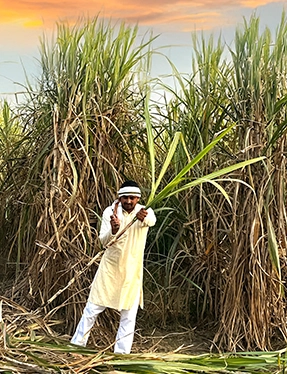
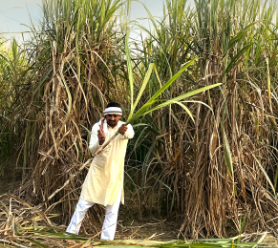
Soil treatment is often overlooked by farmers. Under Project Ek Sau Ek, we introduced Trichoderma harzianum to combat soil-borne diseases like Red Rot (Colletotrichum falcatum).

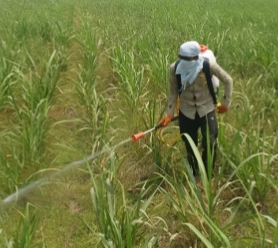

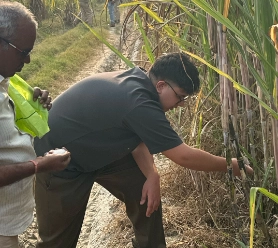
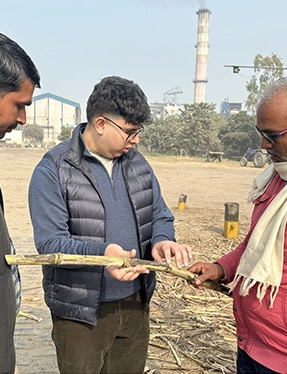
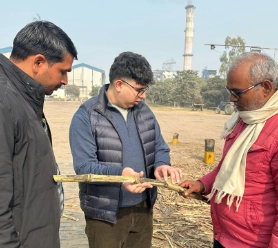
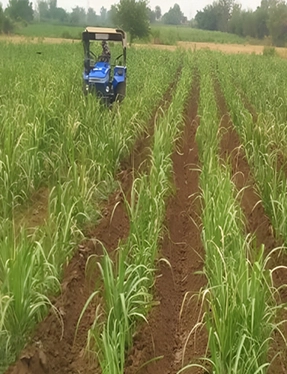
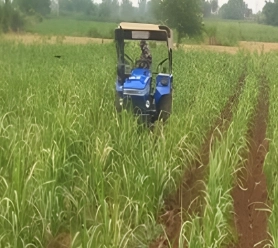
Additionally, Zinc Sulphate (ZnSO₄) and Calcium Nitrate [Ca(NO₃)₂] were applied in various plots, promoting overall plant growth and better yields.

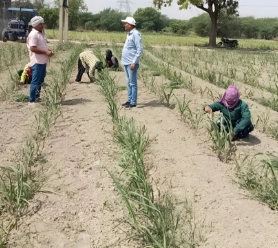
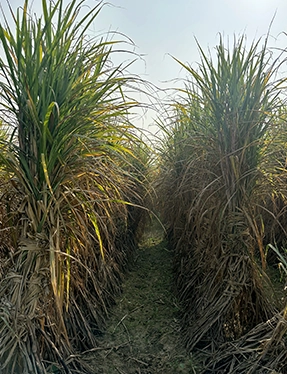
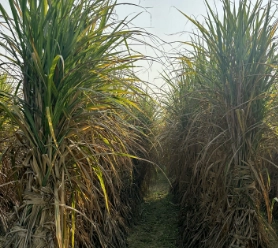
Ground-level harvesting/ stubble shaving with Ratoon Management Device is not important
High stubble length reduces millable sugarcane
Ground-level harvesting/ stubble shaving with Ratoon Management Device is very important
It improves millable sugarcane and yield, leading to higher income
Burning sugarcane trash has no negative impact
Burning sugarcane trash depletes soil nutrients, beneficial microbes, and nitrogen
Mulching sugarcane trash increases organic carbon, nitrogen, phosphorus, and micronutrients in the soil
Mulching also conserves soil moisture, controls weeds, and increases sugarcane yield
Delayed ratoon management has no negative impact
Delayed ratoon management reduces tillering and yield
Timely irrigation, hoeing, and weeding help in better tillering
Timely irrigation, weeding/hoeing, and nitrogen application are beneficial for ratoon crop growth and yield
Gap filling in ratoon is not required
Without gap filling, sugarcane yield will be lower
Gap filling is very important
Gap filling is done by planting two-budded sets or pre-germinated sets in the gaps; it leads to higher yield
Ratoon crop needs the same amount of nitrogen as the spring sugarcane plant crop
Less nitrogen in ratoon leads to lower yield
The ratoon crop needs 20–25% more nitrogen compared to the spring crop
20- 25% extra nitrogen leads to better ratoon yield
Applying a basal fertiliser dose over seeds is effective
This can damage the bud resulting in wastage of fertilisers (excess cost)
Applying basal fertilisers in the furrow before planting is more effective
This ensures proper nutrient uptake and minimizes fertiliser wastage
A thick and excess soil covering over sugarcane seeds is better
This results in less and delayed germination
A light soil covering of 5 to 6 cm over sugarcane seeds is ideal
This enhances germination and root aeration which will improve yield
Flood irrigation provides more water to the crop and is the best method
Flood irrigation leads to poor tillering, unnecessary water usage and low yield
Furrow irrigation is a much more effective method of supplying water
It requires less water which lowers costs and improves yield
Earthing-up has no effect on the sugarcane crop
Not doing Earthing-up causes sugarcane logging (falling over)
Earthing-up with Potash is beneficial
It stabilises the plant and supports growth and improves yield
Planting in a row distance of 2 to 2.5 feet is the best
This requires extra seeds and results in less millable sugarcane. It also doesn’t allow for intercropping which can lower income
A row-to-row distance of minimum 4 feet is better
It requires fewer seeds and improves yield and allows intercropping which results in extra income
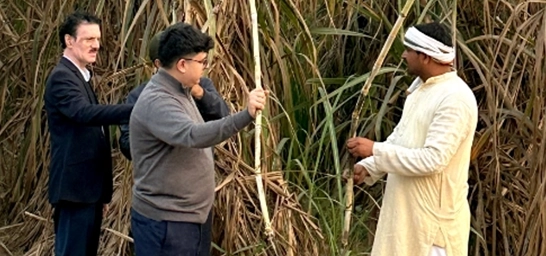
Haqdarshak is an eight-year-old social impact organisation dedicated to making access to welfare schemes easy and transparent. Present in 25 of India’s 28 states, Haqdarshak uses a combination of technology and a field network of support agents — primarily women — to connect farmers, informal workers, micro-businesses, and underprivileged families to government schemes and financial services.


A digital card enabling individuals to access information about their entitlements, including social security, government schemes, and financial services.
Target-driven doorstep service delivery for both government-sponsored and private welfare schemes.
The model focusses on creating livelihood opportunities for the trained cadre of service agents.
Community-led centres that provide sustainable, local access to social protection services.
Programs aimed at increasing awareness of digital tools and financial services, supporting education, skill development, and entrepreneurship.
Facilitating access to schemes related to climate change adaptation and mitigation.
Hosting government schemes on third-party apps through seamless API connections.
Project Ek Sau Ek’s innovative methods have shown significant improvements over conventional sugarcane cultivation practices, delivering measurable benefits in yield, input efficiency, and overall crop health.
Seed Savings and Better Germination: Project techniques led to noticeable savings in seed quantity while improving germination rates, ensuring healthier and more uniform crop stands.
Improved Tillering and Millable Cane: Enhanced tillering resulted in a higher number of millable canes, directly contributing to increased yield potential.
Stronger Cane Growth: Sugarcane exhibited improved girth and height, indicators of robust plant health and better juice content.
Enhanced Sunlight Interception: The 4-feet spacing between rows allowed for better sunlight penetration, which boosted photosynthesis and overall plant vigour.
Efficient Resource Utilisation: Wider spacing improved the absorption of irrigated water and applied fertilisers, maximising resource use.
Simplified Field Operations: The space between rows made it easier to perform intercultural activities such as:
Weeding
Hoeing
Spraying
Earthing-up
Propping
Intercropping Opportunities: The wider row spacing also enabled farmers to cultivate intercrops like tomato, cauliflower, and pulses, diversifying income sources and optimising land use.
Plots using Project Ek Sau Ek’s methods consistently outperformed control plots in yield, proving that the combination of improved techniques and proper spacing can lead to higher productivity with lower input costs.
These results highlight the effectiveness of Project Ek Sau Ek’s interventions, demonstrating that thoughtful adjustments to traditional practices can deliver tangible benefits for farmers.
The use of new techniques has increased sugarcane by 25-30%, with improved quality. The sugarcane now grows up to 13 feet, earlier it was just 9-10 feet.
Project Ek Sau Ek has brought a lot of improvement to our lives. With the increased sugarcane yield, our income has grown, and we were able to build a new house.
In the 2023–24 season, we launched Project Ek Sau Ek, a targeted rural development programme aimed at enhancing sugarcane productivity while strengthening the socio-economic resilience of farming communities. Implemented across 26 villages in Bulandshahr district and engaging 100 farmers, the initiative delivered expert-led capacity building on easy to adopt sugarcane cultivation practices, adoption of scientifically backed practices and precision-driven crop management. In collaboration with Haqdarshak, we further facilitated farmer enrolment in government welfare schemes, thereby improving access to institutional support and social security benefits.
Building on demonstrable success, Project Ek Sau Ek will be scaled to benefit 1,000 farmers in the 2025–26 season. The expanded programme will deliver structured, science-based training modules encompassing soil health diagnostics, targeted soil amendments, deep tillage, optimised plant spacing, trench planting, and site-specific nutrient management based on soil test results. Integrated pest and disease management protocols will be promoted to minimise crop losses while reducing chemical dependency. Water resource stewardship will form a critical pillar of the next phase, incorporating furrow irrigation systems, soil moisture monitoring through sensor technology, and drone-assisted crop management to optimise input use. The programme will embed climate-resilient agronomic strategies and deploy digital tools for precision agriculture, enabling real-time decision-making.
In parallel, Project Ek Sau Ek will facilitate stronger market linkages, and farmer-oriented financial literacy initiatives, empowering participants to secure remunerative prices and optimise production costs. Through a holistic approach that integrates scientific innovation with social empowerment, the initiative seeks to foster sustainable agricultural intensification, improve rural incomes, and catalyse long-term prosperity for smallholder and marginal farmers
A Sugarcane Farmers’ Meet and Knowledge Sharing Program was organized at Triveni Engineering and Sugar Industries Ltd., Sabitgarh on 14th August 2025. The event was conducted by the Project Ek Sau Ek team, in association with the World Wide Fund for Nature (WWF), a Swiss-based international non-governmental organization.
The program witnessed the participation of Project Ek Sau Ek sugarcane farmers along with progressive sugarcane growers from the districts of Bijnor, Moradabad, and Amroha.
The session began with a presentation by Yash Sawhney highlighting the success of Project Ek Sau Ek and its impact on sustainable sugarcane farming. Farmers actively participated in an open discussion, sharing modern and scientifically proven interventions to enhance sugarcane productivity and reduce cultivation costs.
Yash Sawhney addressed the gathering and emphasized the economic and agronomic benefits of adopting these interventions for higher yields and sustainable farming.
The program concluded with an interactive session, where farmers shared their experiences and reaffirmed their commitment to adopting sustainable practices for increasing sugarcane yield per hectare while reducing input costs.
Sugarcane yields in District Bulandshahr, Uttar Pradesh, have been declining, posing challenges for farmers. A study of 100 farmers tested sustainable practices—such as pest- and disease-resistant varieties, trench planting, precise nutrient and water management, and integrated pest control. These methods improved germination, tillering, yields, pest resistance, and heat tolerance without significantly increasing costs. Wider adoption could enhance farmer incomes and sugarcane supply chains. Findings from Project Ek Sau Ek will be presented at the ISSCT Congress in Cali, Colombia, in August 2025 by Mr. J.J. Bhagat, Mr. C.K. Dixit, and Mr. Yash D. Sawhney.

Kisan India | 19th May, Noida

Times Now | 12th May, Noida

The Times of India I 7th Oct, Mumbai
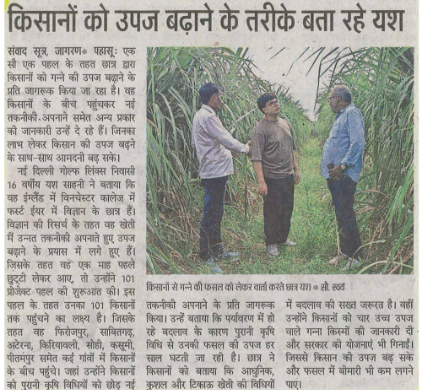
Dainik Jagran I 27th Aug, New Delhi

Amar Ujala I 27th Aug, New Delhi
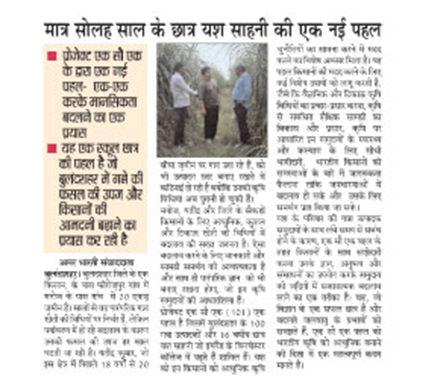
Amar Bharathi I 26th Aug, New Delhi
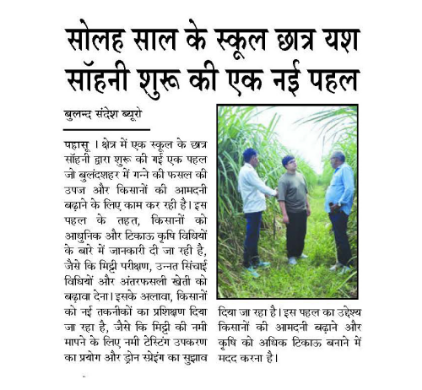
Buland Sandesh I 26th Aug, Ghaziabad
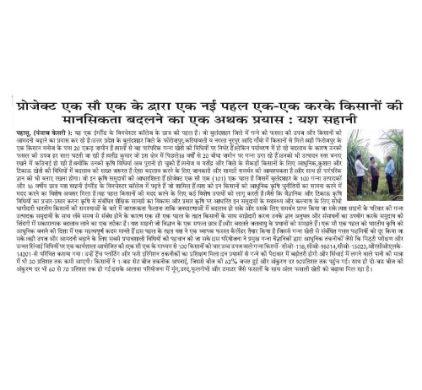
Punjab Kesari I 26th Aug, Delhi

Virat Bhaibhav I 26th Aug,New Delhi

Vishwa Guru I 26th Aug,Noida

Aligarh Express I 26th Aug, Aligarh